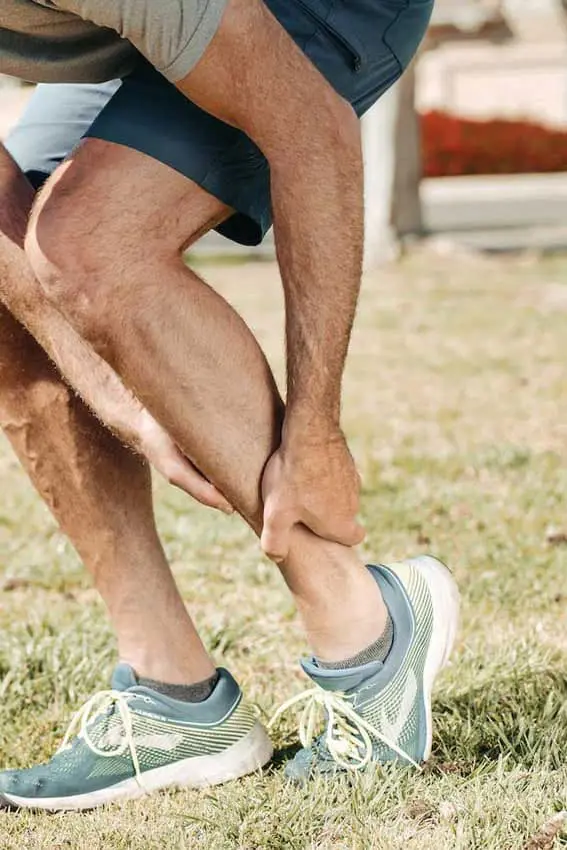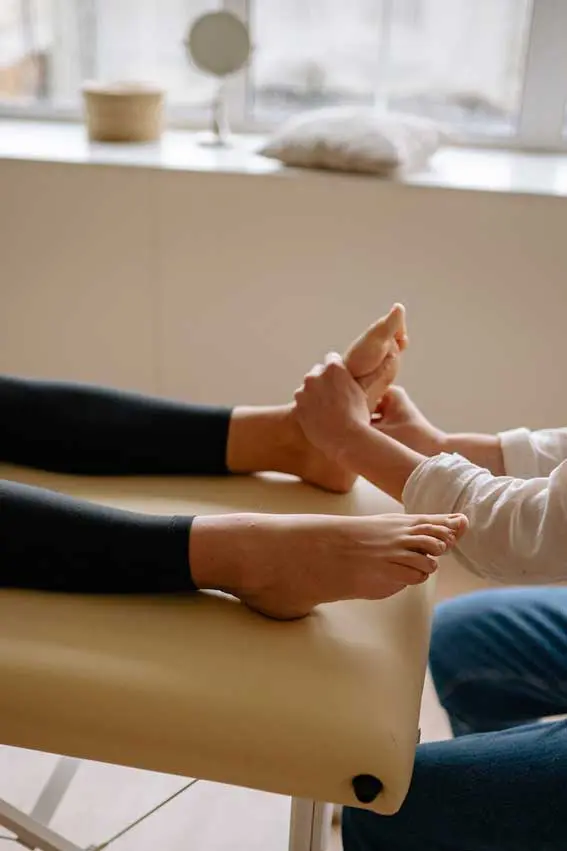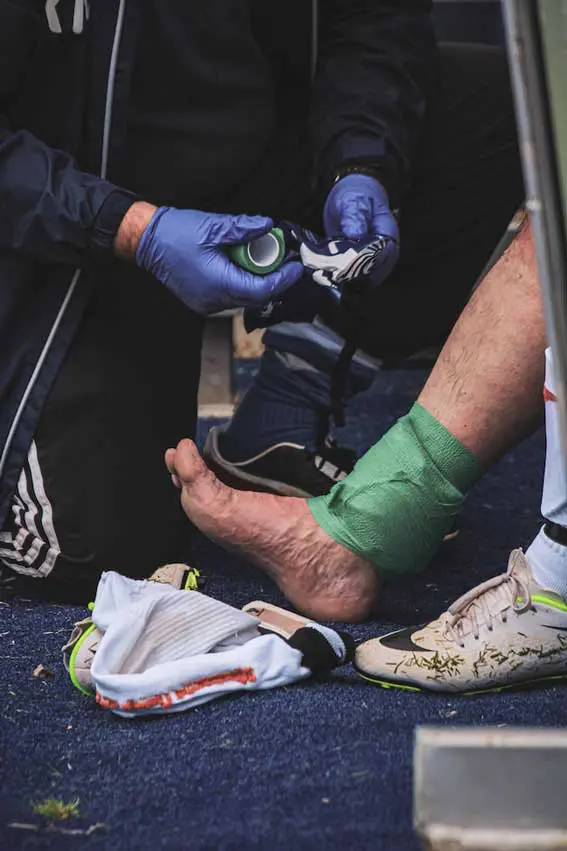Achilles Tendonitis Therapy
Your Achilles tendon is the largest in your body, connecting your calf muscle and heel bone. You wouldn’t be able to walk, stand on your tiptoes, run, or jump without the great function of your Achilles tendon.
When you repeatedly aggravate this tendon and put it under stress without enough time to rest and recover, you can develop Achilles tendonitis. Dr. Cameron, the premier Achilles tendon specialist in Utah, understands the importance of an early diagnosis for your treatment course. If left too long, tendonitis can become chronic Achilles tendinopathy, requiring much longer and more invasive therapies.
Here are some easy tips for prevention before you need Dr. Cameron’s help:
Preventing Achilles Tendon Injuries
Achilles tendon injuries are common and painful, limiting physical activity and reducing your overall quality of life. Maintaining a healthy weight and lifestyle will go a long way to protect your tendons and the rest of your body. When you are frequently exercising, remember to:
- Gradually increase the intensity or duration of your physical activity. Forget the motto “no pain, no gain,” as you will be in a lot of pain if you bring on an Achilles tendon injury
- Warm up and stretch before all physical activities
- Perform calf and ankle strengthening exercises
- Wear supportive footwear that’s suited for your physical activity and fits well
- Rest and allow for recovery time
You should also practice these tips if you have a physically demanding job. Standing on your feet all day in the incorrect shoes can trigger Achilles tendonitis just as frequently as forgetting to stretch before your basketball game.


Achilles Tendon Injuries
There are two types of Achilles tendon injuries. The first is a complete tendon rupture, categorized by full or partial tear. Typically caused by sudden or forceful movements like jumping or pivoting, you might even hear a popping or snapping sound at the time of injury. It can be excruciating and hard to walk at all. You may see visible bruising or discoloration after the initial injury. If you struggle to stand on your tiptoes, see a doctor immediately.
The second injury is Achilles tendonitis. This is typically from overuse or repetitive stress resulting in inflammation, so it’s more likely to affect physically active people. Many runners and athletes struggle with Achilles tendonitis when they increase the intensity or duration of their workouts.
Other causes could be:
- Improper warm-ups or failure to cool down without stretching
- Exercising on hard or uneven surfaces
- Flat or high arches without adequate support
- A weakened immune system, poor circulation, and associated medical conditions like gout or rheumatoid arthritis
- Obesity, which puts more stress on your muscles, joints, and tendons
- Shoes that fit poorly, lack proper support, or are too loose or tight
- Overly tight calf muscles or muscle weakness in lower legs
- Repetitive overuse or stress to the tendon from your job or other activity
Symptoms of Achilles Tendonitis
Because the Achilles tendon runs from your heel bone to your calf muscle, you commonly experience pain and stiffness on the back of your heel. It can stiffen when cold, so the pain can worsen in the morning after sleeping all night or after resting.
You can also experience redness or warmth in the irritated area of the tendon. It could be tender or swollen. You can struggle to move or rotate your ankle, which might creak or crack when you move it.
What Are The Treatments For Achilles Tendon Injuries
The treatment for Achilles tendonitis depends on the severity. If it’s mild, you can often get away with home care such as rest, ice, and over-the-counter pain relievers, alternating between ibuprofen and acetaminophen. Resting your affected leg and avoiding physical activity can reduce stress on your Achilles tendon. Ice and ibuprofen will help with the swelling and pain.
You should consult an Achilles tendon specialist before starting a home treatment plan. In more severe cases, you should continue the above treatment plan while pursuing more treatments for Achilles tendonitis:
- Prescriptions
An Achilles podiatrist can prescribe custom orthotics or shoe inserts to support your feet and keep them in proper alignment. This will reduce the pressure on your tendon and prevent future aggravation. Your doctor can prescribe prescription anti-inflammatory medication like naproxen to help speed recovery, or more potent pain medication if warranted. - Immobilization
If the irritation is severe, your doctor may recommend complete rest by using crutches to walk for a period. They may suggest a walking brace or cast to immobilize your foot, allowing the tendon to heal fully. - Physical Therapy/Surgery
When your Achilles tendonitis isn’t responding to other treatments, you may need physical therapy and/or surgery on your Achilles tendon.

Physical Therapy For Achilles Tendonitis
Physical therapy is often the best course of treatment. Many people find it to be their answer for an Achilles tendonitis cure. After your doctor refers you for therapy, the physical therapist will assess your baseline pain, strength, and range of motion. They will create an individualized treatment plan to restore your mobility to a functional level, considering your goal of treatment too. They target relieving your pain and inflammation and improving muscle tone and flexibility.
Starting with pain relief, they may use both ice and heat therapies. They may also incorporate manual therapies such as massage, myofascial release, and joint mobilization. Depending on their training, they can integrate dry needling and acupuncture or recommend you see someone who can treat you with those. They may deploy ultrasound therapy, using high-frequency sound waves to stimulate blood to your tendon, promoting healing.
They may use kinesiology tape to support your tendon or recommend an ankle brace to reduce stress on the affected area. After they’ve addressed pain, inflammation, and support, they will give you stretching and strengthening exercises. They will choose specific ones that suit your needs and practice them with you before sending you home to do a daily run-through. They could include:
- Balancing
Single-leg balancing, wobble board exercises, and heel-to-toe walks. Working on balance will improve your ankle stability to reduce the risk of future injuries. - Strengthening
These will focus on strengthening the muscles around your tendon to provide more support, such as toe raises, calf raises, and single-leg squats. - Stretching
Stretches for your calf muscle will be particularly important, as any tightness here can contribute to Achilles tendon issues. They can have you practice standing, seated, and wall calf stretches.
Additionally, your physical therapist may recommend some strengthening exercises when your tendon is under stress, as they can improve strength and flexibility. Start by standing on a step with your heels over the edge. Next, you slowly drop your heels down and back up again. This exercise can go a long way in your tendon recovery. If you aren’t seeing the results or need surgery, follow up with an Achilles podiatrist.
Why See A Podiatrist For Achilles Tendonitis
An Achilles tendon specialist or podiatrist can help in several ways throughout your treatment:
- Complementary Treatments
They can create a treatment plan that spans multiple disciplines related to your foot and ankle health. This can include physical therapy, surgery, medication, orthotics, and alternative medicines. - Extra Support
Because they routinely prescribe footwear, orthotics, and braces to patients for their various foot ailments, they are the best at getting you the extra support you need. They can also give expert advice and guidance on footwear choices and mainstream brands depending on your activity level and the movements you will be performing. - Surgical Recommendation
Depending on your response to other treatments and the extent of your condition, podiatrists are the most qualified doctors to assess your need for Achilles tendon surgery and refer you to a specialist if needed.


How Dr. Cameron Helps Achilles Tendonitis Treatment
With years of experience, Dr. Cameron is the Achilles tendon doctor you want to see. If you decide to see him before a formal diagnosis, he could help with the following:
Diagnosis
Having treated many patients with Achilles tendonitis, Dr. Cameron can diagnose you by reviewing your medical history and performing a thorough examination of your foot and ankle. Since he is a foot and ankle reconstructive surgeon, he is comfortable ordering imaging tests such as an x-ray or MRI when necessary. He understands that an efficient and accurate diagnosis is essential to determine an appropriate treatment plan and alleviate discomfort.
Achilles Tendonitis Treatment Plans
Once you have a diagnosis, Dr. Cameron is the quarterback you want, calling the shots and running the plays. He maintains several professional memberships to stay on top of all the current and upcoming Achilles tendonitis therapy. Because of his surgical training, Dr. Cameron can make an educated assessment about whether you need Achilles tendon surgery. The good news is that he can perform the surgery if necessary, eliminating the stress of switching doctors.
Achilles Tendon Surgery
Dr. Cameron is also a board-certified reconstructive surgeon for feet and ankles, so he is understandably the region’s top Achilles tendonitis podiatrist. He never recommends unnecessary surgery as it’s not without its risks: nerve damage, infection, blood clots, complications from anesthesia, and delayed Achilles tendon healing.
Achilles tendon surgery is typically only recommended for tendonitis when it’s turned into tendinopathy. Chronic Achilles tendinopathy is when your tendonitis causes the tendon to be chronically inflamed, thickening, and degenerating. To promote healing, Dr. Cameron will remove the damaged tissue surgically.
He performs three specialty Achilles tendon repair surgeries:
- Percutaneous Surgery
This involves several small incisions around the damaged tendon. Dr. Cameron uses a special tool to repair or remove the damaged tissue as indicated. - Open Surgery
Dr. Cameron makes a large incision on the back of your leg to access the injured tendon. This is typically for torn tendons, as the larger incision allows him to sew the torn tendon back together. In some tendonitis cases, a larger incision helps remove all the damaged tissue. - Mini-Open Surgery
Blending the two previous surgeries, Dr. Cameron can use smaller incisions while performing a tear repair or removing damaged tissue.
Your surgeon typically determines the method of surgical repair based on your injury type and the extent of the damage. You want a seasoned surgeon like Dr. Cameron to select the best plan for you to minimize the risk of the surgery not fixing your problem. He also discusses any viable options with you and will go into further detail about the implications of each route.
After surgery, you must wear a cast or walking boot and crutches for several weeks to protect the repaired tendon. Then, you may still need physical therapy to rehabilitate the repaired tendon, increase flexibility and joint mobility, and regain strength in the affected leg. Surgical recovery can take several months, so you shouldn’t expect an immediate Achilles tendonitis cure.
Don’t wait until you need a surgical repair or have a chronic condition. If you feel twinges when jumping or standing on your tip toes, it’s time to give Dr. Cameron a call.
